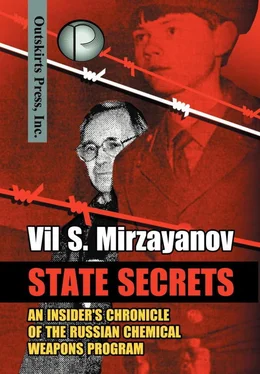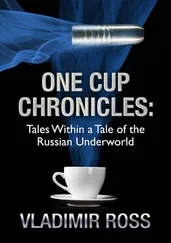On the outside, it seemed that nothing had happened. I continued preparing my experiments and began my own research in the comparative analysis of the kinetics of the adsorption of chemical agents on active carbon and other adsorbents used for concentrating admixtures and the necessary follow-up, along with further chromatographic analysis. Additionally, I was studying the kinetic performance of the catalytic adsorbents used in modern gas masks.
I worked practically alone (only rarely did Bogomazov give me a laboratory assistant for help), and I got tired of the long drawn-out experiments in which I had to take gas samples every 5 minutes and analyze them over a 3-4 hour period. However, some kind of inspiration was pushing me forward and I was getting a lot of satisfaction from my work. I obtained unique data that allowed me to understand what processes were taking place in the concentrating columns and to choose the right adsorbent for them.
The research on the kinetic performance of gas-mask filters also produced very interesting results. For the first time ever, we obtained adsorption fronts for chemical agents on the gas masks used by the Soviet Army.
During the course of that research, I developed a series of methods for concentrating small quantities of chemical agents in the air and in liquids. My developments were registered and I received patents for them.
By that time, I understood that I would not be able to defend my doctoral thesis as it was. I would have to revise and rewrite it. I knew that would be tremendous work, but I was not afraid of it. I began writing my thesis again – at home, in my apartment. For that purpose, I invented a special system of codes for all the chemical agents mentioned in the work. That way, the theoretical calculations, diagrams, and charts did not contain any secret information, and I did not violate confidentiality. I could write late at night and on my days off, without running to the institute’s First Department for special permits to work at GOSNIIOKhT in the evenings.
It was time for a more thorough examination of the results showing breakthrough for the thionic analogs of soman and sarin.
To the great regret of the authors of the discovery, and to my greatest joy, the analysis of the samples, carried out with the help of my chromatograph with a selective detector, showed no breakthrough effect for a 10 minute period after the air with the chemical agents began flowing through the filter. Repeating the tests always gave the same result.
By the middle of the summer of 1983, Bogomazov finally acknowledged his mistake, but he continued to play the role of a great inventor saying that it was possible there could have been some experimental error in my work. But there was no error.
You had to give Bogomazov credit for his initiative and enterprising abilities. He soon established good relationships with other research institutes that were working on the “Foliant program” and developing individual means of protection.
Along with Bogomazov, I visited the Elektrostal Technological Research Institute (ENITI) for the first time. It was the leading scientific institution that was developing gas masks and filters for military equipment and installations (command posts, air-raid shelters, and so forth).
ENITI’s director, Vladimir Smirnov impressed me favorably with his proficiency in very different areas of the adsorption processes, chromatography, and adsorption material production technology. All the research fellows at ENITI who I later worked with were very well informed. I’m very grateful to them for their help with my research. Although science in Russia is going through very tough times now, I am sure that ENITI will survive and continue doing science, because it makes peaceful products for people’s protection.
In 1985, I asked Smirnov to be one of my official opponents, at the defense of my doctoral thesis, and he agreed at once. He wrote a very favorable review, which played a great part in my successful defense.
Dubov and Bogomazov got out of their thorny situation, by putting a positive spin on the failure of the “breakthrough”. From what I know, they asked the UNKhV to relax the requirements for the initial concentration of chemical agents, and naturally their request was rejected. This made it look as though GOSNIIOKhT had developed a method for breaking through the gas mask filter, but they could not meet the requirements of the capricious military.
In fact, even if the initial concentration of chemical agents had been 10 times higher, it would not have created the required breakthrough effect. But nobody dared to say anything about that. With his usual brilliance, Dubov substantiated the need to expand in-depth research of adsorption of aerosolized chemical agents in the gas-mask filter.
Anyway, that work was not useless or wasted. Many new facts were discovered in the course of the research. In particular, it was discovered that the vapor of chemical agents remains unchanged on an adsorbent catalyst for a long time. I think this is a rather dangerous discovery for reasons of health protection. Somebody might try to develop a method of displacing toxic agents from the adsorptive catalyst and drive them into the lungs. On the other hand, this discovery creates a number of other disturbing questions about how gas masks can possibly be used again after they have been used for filtering contaminated air, for example at a factory for destroying chemical weapons.
What is the legal status of a contaminated gas mask? Can every used mask be regarded as a carrier of potentially hazardous chemical agents, even in small quantities? I am not ruling out the possibility of using gas-mask filters for the purposes of intelligence and industrial espionage.
Under the circumstances, it is interesting that the aforementioned graduate student, Valery Belikov, “discovered” a peculiar thermal effect in activated carbon, which allegedly took place when a chemical agent was breaking through the gas-mask filter. Of course, that was sheer juggling of the data, because, as my experiments convincingly proved, not one of the tested substances could break through the filter. However, none of this bothered Belikov, or prevented him from completing his work and defending his master’s thesis without a trace of embarrassment. I regret that I didn’t dare talk about this openly at the preliminary defense of Belikov’s thesis. At that time, I really did not want to enter into conflict with my new bosses, who certainly knew about everything.
After he received his degree, Belikov joined the Communist Party. He had to wait for his party membership for several years because of the notorious enrollment quotas set by the Central Committee of the CPSU: three workers to one intellectual.
It’s worth mentioning that Belikov was the last secretary of the Party Committee at GOSNIIOKhT. He was elected when the party had already fallen to pieces and only the department heads and Director Petrunin remained. President Yeltsin issued a decree after crushing the coup attempt in August of 1991, and it banned all political parties at enterprises.
Despite all the problems connected with his failed discovery, Bogomazov managed to get the maximum benefit from our collaboration.
Bogomazov was watching me at work with the Varian 3700, an American gas chromatograph, and he noticed that I was using the special tips filled with rubidium sulfate for the thermionic detector very thriftily and carefully. The tips were packaged together with the new chromatograph in small quantities, and when they were used up it was extremely difficult to buy new ones. My friend Sergey Pichidze from Shikhany used to supply me with them occasionally. At that time, however, I only had a very small stock of new ones.
Hard currency at that time was always in short supply in GOSNIIOKhT, and if we ran out of the detector tips, it could have stopped our experiments. Our repeated attempts to refill the used heads by pressing fine rubidium sulfate powder into them did not give us positive results. Maybe we were not persistent enough.
Читать дальше












